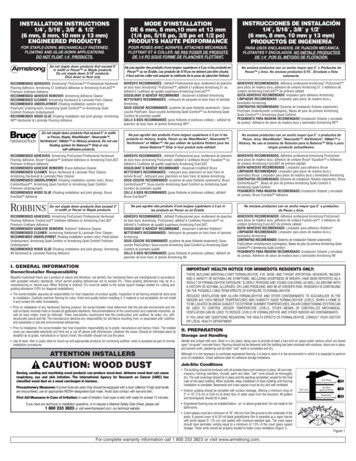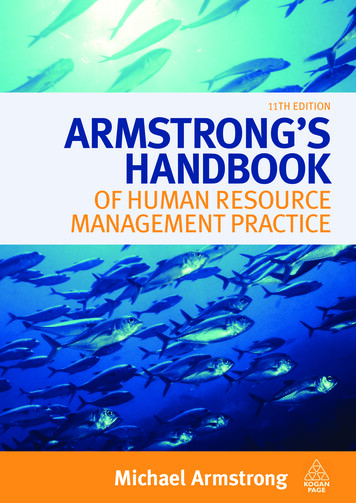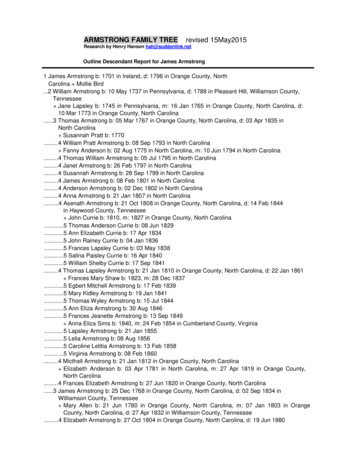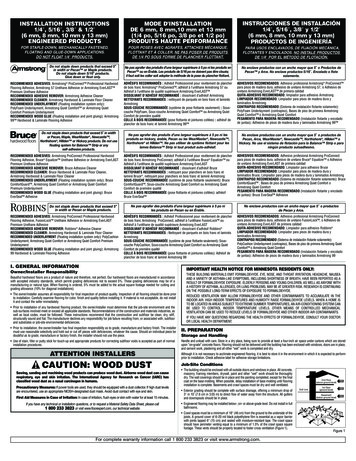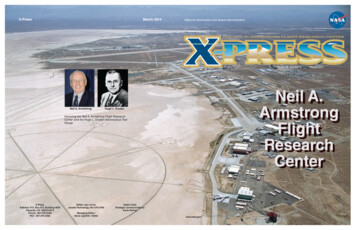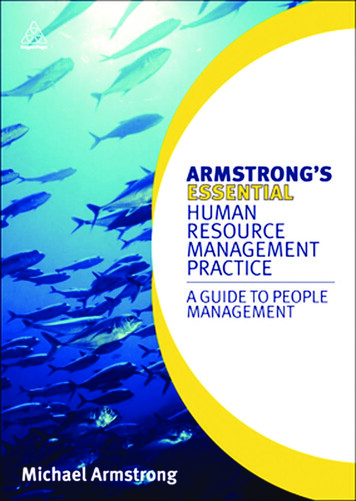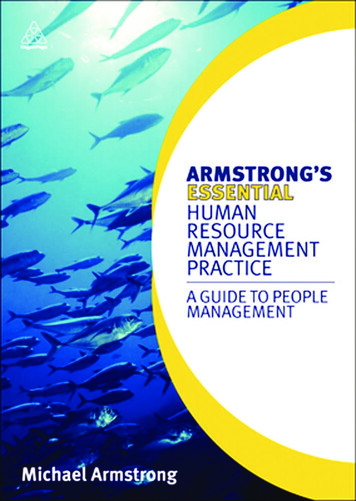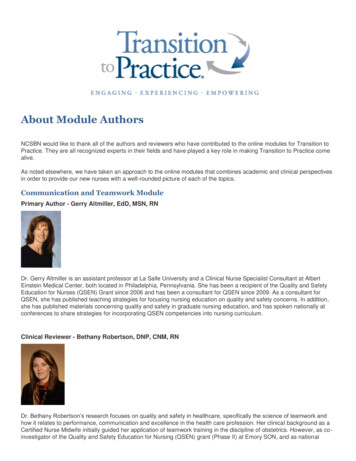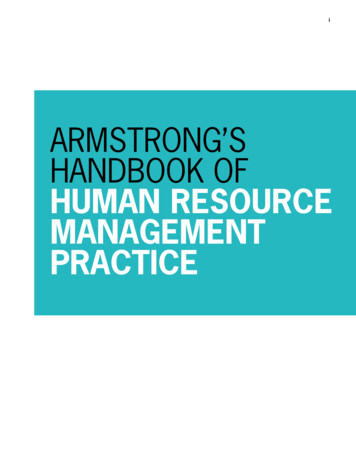
Transcription
iARMSTRONG’SHANDBOOK OFHUMAN RESOURCEMANAGEMENTPRACTICE
iiA L S O AVA I L A B L E B YMICHAEL ARMSTRONGArmstrong’s Handbook of Management and LeadershipArmstrong’s Essential Human Resource Management PracticeArmstrong’s Handbook of Strategic Human Resource ManagementArmstrong’s Handbook of Performance ManagementArmstrong’s Handbook of Reward Management PracticeHow to Manage PeopleHow to be an Even Better ManagerHuman Capital Management (with Angela Baron)The Reward Management Toolkit (with Ann Cummings)Evidence-based Reward Management (with Duncan Brown and Peter Reilly)www.koganpage.com
MICHAEL ARMSTRONGAND STEPHEN TAYLOR13TH EDITIONARMSTRONG’SHANDBOOK OFHUMAN RESOURCEMANAGEMENTPRACTICEiii
ivPublisher’s noteEvery possible effort has been made to ensure that the information contained in this book isaccurate at the time of going to press, and the publishers and authors cannot accept respon sibility for any errors or omissions, however caused. No responsibility for loss or damageoccasioned to any person acting, or refraining from action, as a result of the material in thispublication can be accepted by the editor, the publisher or any of the authors.First edition published in 1977 as A Handbook of Personnel Management Practice by Kogan PageLimitedSeventh edition published in 1999 as A Handbook of Human Resource Management PracticeEleventh edition published in 2009 as Armstrong’s Handbook of Human Resource ManagementPracticeTwelfth edition 2012Thirteenth edition 2014Apart from any fair dealing for the purposes of research or private study, or criticism or review, aspermitted under the Copyright, Designs and Patents Act 1988, this publication may only be repro duced, stored or transmitted, in any form or by any means, with the prior permission in writing of thepublishers, or in the case of reprographic reproduction in accordance with the terms and licencesissued by the CLA. Enquiries concerning reproduction outside these terms should be sent to thepublishers at the undermentioned addresses:2nd Floor, 45 Gee StreetLondon EC1V 3RSUnited Kingdomwww.koganpage.com1518 Walnut Street, Suite 1100Philadelphia PA 19102USA4737/23 Ansari RoadDaryaganjNew Delhi 110002India Michael Armstrong, 1977, 1984, 1988, 1991, 1995, 1996, 1999, 2001, 2003, 2006, 2009, 2012, 2014The right of Michael Armstrong to be identified as the author of this work has been asserted by himin accordance with the Copyright, Designs and Patents Act 1988.ISBNE-ISBN978 0 7494 6964 1978 0 7494 6965 8British Library Cataloguing-in-Publication DataA CIP record for this book is available from the British Library.Library of Congress Cataloging-in-Publication DataArmstrong, Michael, 1928Armstrong’s handbook of human resource management practice / Michael Armstrong. –13th Edition.pages cmISBN 978-0-7494-6964-1 – ISBN 978-0-7494-6965-8 (ebk) 1. Personnel management–Handbooks,manuals, etc. I. Title. II. Title: Handbook of human resource management practice.HF5549.17.A76 2013658.3–dc232013038558Typeset by Graphicraft Limited, Hong KongPrint production managed by JellyfishPrinted and bound in the UK by Ashford Colour press Ltd
vContents in brie fList of figures xxvList of tables xxviiList of exhibits xxixPreface xxxiiiPa r t I The practice of human resource management01The essence of human resource management (HRM)02Strategic HRM03Delivering HRM – systems and roles04HRM and performance05Human capital management06Knowledge management7707Competency-based HRM8508The ethical dimension of HRM9509Corporate social responsibility105315355367Pa r t I I People and organizations10Organizational behaviour11Work, organization and job design12Organization development113115135153Pa r t I I I Factors affecting employee behaviour13Motivation14Commitment15Employee engagement1691851931671
viContents in BriefPa r t I V People resourcing16Strategic resourcing20917Workforce planning21518Recruitment and selection19Resourcing practice24720Talent management263207225Pa r t V Learning and development28121Strategic learning and development22The process of learning and development29123The practice of learning and development30124Leadership and management development283Pa r t V I Performance and reward32133125Performance management26Reward management – strategy and systems27The practice of reward management36928Managing reward for special groups391Pa r t V I I Employee relations40333329Strategic employee relations30The employment relationship31The psychological contract32The practice of industrial relations33Employee voice34Employee communications405413419431437425357
Contents in BriefPa r t V I I I Employee well-being35The practice of employee well-being36Health and safety443445453Pa r t I X International HRM46337The international HRM framework46538The practice of international HRM47739Managing expatriates495Pa r t X HRM policy and practice40HR policies41HR procedures42HR information systems43Employment law507509517525531Pa r t X I HR skills54344Strategic HRM skills45Business skills46Problem-solving skills47Analytical and critical skills48Research skills49Statistical skills50Selection interviewing skills51Job, role and skills analysis and competency modelling52Learning and development skills53Negotiating skills54Leading and facilitating change545553563567573583589619625631603vii
viiiContents in Brief55Leadership skills64156Influencing skills65157Handling people problems58Managing conflict59Political skills657665671Pa r t X I I HRM toolkits67560Strategic HRM toolkit61Human capital management toolkit62Organization design toolkit63Organization development toolkit64Employee engagement toolkit65Workforce planning toolkit71766Talent management toolkit72967Planning and delivering learning events toolkit68Performance management toolkit69Strategic reward toolkit70Total rewards toolkit71Job evaluation toolkit72Grade and pay structure design toolkit73Attitude surveys toolkit677685697701709747761771777789801Appendix 1: Example of attitude survey 811Appendix 2: Survey providers 813About the authors 815Author index 817Subject index 823737
ixContentsList of figures xxvList of tables xxviiList of exhibits xxixPreface xxxiiiPa r t I The practice of human resource management01The essence of human resource management (HRM)Introduction – the HRM concept 4HRM defined 5The philosophy of human resource management 6Underpinning theories of HRM 6Reservations about the original concept of HRM 8Models of HRM 9HRM today 1002Strategic HRM15Introduction 16The conceptual basis of strategic HRM 16The nature of strategic HRM 18Aims of SHRM 18Critical evaluation of the concept of SHRM 19The resource-based view of SHRM 20Strategic fit 22Perspectives on SHRM 22HR strategies 2503Delivering HRM – systems and roles35Introduction 36HR architecture 36The HR system 36The HR function delivery model 38The role and organization of the HR function 38Evaluating the HR function 41The roles of HR professionals 42Carrying out the role of the HR professional 46The HR role of line managers 4931
xContents04HRM and performance53Introduction 54The impact of HR 54How HRM makes an impact 54Developing a high-performance culture 58High-performance work systems 58Performance management 62The contribution of HR 6205Human capital management67Introduction 68The nature of human capital management 68The concept of human capital 68The constituents of human capital 69Approaches to people management raised by human capital theory 70Human capital measurement 70Human capital reporting 73Introducing HCM 7406Knowledge management77Introduction 78The concept of knowledge 78Knowledge management defined 79Knowledge management strategies 79Knowledge management issues 80The contribution of HR to knowledge management 8107Competency-based HRM85Introduction 86Competency defined 86Competency frameworks 89Using competencies 89Applications of competency-based HRM 90Developing a competency framework 91Competencies and emotional intelligence 9308The ethical dimension of HRM95Introduction 96The meaning and concerns of ethics 96The nature of ethical decisions and judgements 96Ethical frameworks 96Equity theory 97Justice 97HRM ethical guidelines 98
ContentsEthical dilemmas 100The ethical role of HR 10109Corporate social responsibility105Introduction 106Corporate social responsibility defined 106Strategic CSR defined 106CSR activities 107The rationale for CSR 108The opposing view 108Benefits of CSR 109The basis for developing a CSR strategy 109Pa r t I I People and organizations10Organizational behaviour113115Introduction 116Organizational behaviour defined 116The sources and applications of organizational behaviour theory 116How organizations function 117Organizational culture 120Organizational climate 123Organizational processes 124Characteristics of people 125Implications for HR specialists 12911Work, organization and job design135Introduction 136Work design 136Organization design 142Job design 145Role development 14812Organization development153Introduction 154Organization development defined 154The nature of organization development 154The story of organization development 155Organization development strategy 158Organizational diagnosis 159Organization development programmes 161Conclusions on organization development 164xi
xiiContentsPa r t I I I Factors affecting employee behaviour13Motivation169Introduction 169The meaning of motivation 170Types of motivation 170Motivation theory 171Motivation and job satisfaction 177Motivation and money 180Motivation strategies 18014Commitment185Introduction 185The meaning of organizational commitment 185The importance of commitment 186Commitment and engagement 187Critical evaluation of the concept of commitment 187Factors affecting commitment 188Developing a commitment strategy 18915Employee engagement193Introduction 193The meaning of employee engagement 194The theory of engagement 194The components of employee engagement 195Drivers of employee engagement 196Outcomes of engagement 197Enhancing employee engagement 197Enhancing job engagement 198Enhancing organizational engagement 199Burnout 201Measuring engagement 201Conclusions 201Pa r t I V People resourcing16Strategic resourcing207209Introduction 209The objective of strategic resourcing 209The strategic HRM approach to resourcing 210Strategic fit in resourcing 210Bundling resourcing strategies and activities 211The components of strategic employee resourcing 211167
Contents17Workforce planning215Introduction 216Workforce planning defined 216Incidence of workforce planning 216The link between workforce and business planning 217Reasons for workforce planning 217Workforce planning issues 217The systematic approach to workforce planning 21718Recruitment and selection225Introduction 226The recruitment and selection process 226Defining requirements 226Attracting candidates 228Dealing with applications 234Selection methods 236Interview arrangements 237Provisional offers and obtaining references 241Checking applications 241Offering employment 242Following up 242Dealing with recruitment problems 24219Resourcing practice247Introduction 247Employee value proposition 247Employer brand 248Employee turnover 249Retention planning 252Absence management 254Induction 257Release from the organization 25820Talent management263Introduction 263Talent management defined 264The process of talent management 266Talent management strategy 269What is happening in talent management 269Career management 270Management succession planning 276xiii
xivContentsPa r t V Learning and development21Strategic learning and development281283Introduction 283Learning and development defined 284Strategic L&D defined 284Aims of strategic L&D 284Learning and development philosophy 285The business case for L&D 286Impact of learning and development on performance 286Learning and development strategies 28622The process of learning and development291Introduction 292How people learn 292The implications of learning theory and concepts 295Organizational learning 295The notion of the learning organization 297Self-directed learning 29923The practice of learning and development301Introduction 302Identifying learning needs 302Approaches to learning and development 305Enhancing workplace learning 306Training 308Planning and delivering learning events 310Blended learning 311Evaluation of learning 311Responsibility for the implementation of learning 31424Leadership and management development321Introduction 322Leadership and management development defined 322The nature of leadership and management 322Leadership and management development compared 323Leadership development 324Management development 326Criteria for leadership and management development 328
ContentsPa r t V I Performance and reward25Performance management331333Introduction 334The basis of performance management 334Aims of performance management 335The performance management cycle 336Performance management issues 341The impact of performance management on performance 345Performance management as a rewarding process 348360-degree feedback 348Introducing performance management 34926Reward management – strategy and systems357Introduction 357Reward philosophy 358Reward strategy 359The reward system 36327The practice of reward management369Introduction 370Reward management defined 370Aims of reward management 370Pay determination 370Market pricing 371Base bay management 373Contingent pay 374Recognition schemes 381Employee benefits 381Evaluating reward 381Administering reward management 38428Managing reward for special groups391Introduction 391Rewarding directors and senior executives 392Rewarding knowledge workers 395Reward management for sales and customer service staff 395Paying manual workers 398xv
xviContentsPa r t V I I Employee relations29Strategic employee relations403405Introduction 405The process of employee relations 406The basis of employee relations 406Employee relations policies 406Employee relations strategies 408Employee relations climate 408Managing with unions 409Managing without unions 410Implementing employee relations strategy 41030The employment relationship413Introduction 413The nature of the employment relationship 413The basis of the employment relationship 414Labour process theory and the employment relationship 415Employment relationship contracts 415Managing the employment relationship 415Developing a climate of trust 41631The psychological contract419Introduction 419The psychological contract defined 419The significance of the psychological contract 420The psychological contract and the employment relationship 420How psychological contracts develop 421The problem with psychological contracts 421Developing and maintaining a positive psychological contract 42132The practice of industrial relations425Introduction 425Trade union membership 426Union recognition 426Collective bargaining 426Collective agreements 427Informal employee relations processes 42933Employee voice431Introduction 431The meaning of employee voice 431The elements of employee voice 432
ContentsCategorization of employee voice 432Expression of employee voice 433Levels of employee voice 433Stages of employee voice 433Effectiveness of employee voice 434Planning for voice 43434Employee communications437Introduction 437The importance of employee communications 438What should be communicated 438Approach to communication 438Communication methods 438Employee communication strategy 44035Pa r t V I I I Employee well-being443The practice of employee well-being445Introduction 445Reasons for concern 446The work environment 446Managerial behaviour 446Work–life balance 446Managing stress 446Sexual harassment 447Bullying 448Services for individuals 448Group employee services 44936Health and safety453Introduction 453Managing health and safety at work 454Health and safety policies 454Conducting risk assessments 455Health and safety audits 456Health and safety inspections 457Accident prevention 458Occupational health programmes 458Measuring health and safety performance 459Communicating the need for better health and safety practices 459Health and safety training 460Organizing health and safety 460xvii
xviiiContentsPa r t I X International HRM37463The international HRM framework465Introduction 465The international scene 466International HRM strategies 466Contextual factors 467Convergence and divergence 46838The practice of international HRM477Introduction 477Workforce planning 478Resourcing 478International talent management 480International performance management 482Reward management 485Multicultural working 489Role of the international HR function 49039Managing expatriates495Introduction 495Why use expatriates? 496RoI on international assignments 496The process of managing expatriates 496Resourcing policies 497Recruitment and selection policies 498Preparation policy 499Assimilation and support 499Career management 500Performance management 500Re-entry policies 501Pay and allowance policies 501Pa r t X HRM policy and practice40HR policies509Introduction 509Why have HR policies? 509Overall HR policy 510Specific HR policies 510Formulating HR policies 515Implementing HR policies 515507
Contents41HR procedures517What are HR procedures? 517Capability procedure 518Disciplinary procedure 519Grievance procedure 520Redundancy procedure 52142HR information systems525Introduction 525Reasons for introducing an HRIS 525The functions of an HRIS 526Features of an HRIS 526Introducing an HRIS 527E-HRM achievements 52843Employment law531Introduction 531The purpose of employment law 532How are these objectives achieved? 533How is employment law enforced? 537HRM and employment law 538Pa r t X I HR skills44Strategic HRM skills543545Introduction 545The strategic role of the HR professional 545The strategic business partner model 546The strategic role of HR directors 547The strategic role of heads of HR functions 547The strategic role of HR business partners 548The strategic contribution of HR advisers or assistants 548The strategic skills required 548HR strategic activities and skills as defined by the CIPD 54810 things to do if you want to be strategic 54945Business skills553Introduction 554Business skills 554Financial skills 554Business models 55746Problem-solving skills563Introduction 563Problem solving 56312 problem-solving steps 564xix
xxContents47Analytical and critical skills567Introduction 567Evidence-based management 567Analytical skills 569Logical reasoning 569Critical thinking 570Critical evaluation 570Developing and justifying original arguments 57148Research skills573Introduction 574The nature of research 574Planning and conducting research programmes 574Research methodology 576Methods of collecting data 576Processes involved in research 58049Statistical skills583Introduction 584Using statistics 584Frequency 584Measures of central tendency 584Measures of dispersion 585Correlation 585Regression 585Causality 586Tests of significance 586Testing hypotheses 58750Selection interviewing skills589Introduction 590Selection interviewing skills 590Preparing for the interview 591Planning the interview 592Questioning techniques 593Coming to a conclusion 598Dos and don’ts of selection interviewing 59951Job, role and skills analysis and competency modellingIntroduction 604Definitions 604Job analysis 605Job descriptions 607Role analysis and role profiles 608603
ContentsSkills analysis 609Faults analysis 612Job learning analysis 612Competency modelling 61252Learning and development skills619Introduction 619Coaching 619Mentoring 620Job instruction 62153Negotiating skills625Introduction 625The process of negotiation 626Stages of negotiation 626Negotiating and bargaining skills 62854Leading and facilitating change631Introduction 631The role of HR in leading and facilitating change 631The change process 633Change models 633Resistance to change 635Implementing change 636The role of change agents 63755Leadership skills641Introduction 641The meaning of leadership 641Leadership theories 642What leaders do 642Leadership styles 643Types of leaders 644The reality of leadership 646The qualities of a good leader 646Effective leadership 64656Influencing skills651Introduction 651Persuading people 651Case presentation 652Making a business case 653Facilitating 654Coordinating discussions 655xxi
xxiiContents57Handling people problems657Introduction 657Disciplinary issues 657Absenteeism 659Handling poor timekeeping 660Handling negative behaviour 660Dealing with underperformance 66358Managing conflict665Introduction 665Handling inter-group conflict 666Handling interpersonal conflict 666Resolving conflict between team members 66759Political skills671Introduction 671Typical political approaches 672Using political means to get things done 672Political sensitivity 672Dangers of politics 673Dealing with organizational politics 673Pa r t X I I HRM toolkits60Strategic HRM toolkit675677Purpose of the toolkit 677The strategic HRM framework 677Strategic HRM activities 67861Human capital management toolkit685Purpose of the toolkit 685The human capital management approach 685The process of human capital management 685Reasons for adopting an HCM approach 685Introducing HCM 69162Organization design toolkit697Purpose of the toolkit 697Analysis of aims and purpose of the organization 698Activities and structure analysis 699Role analysis 700
Contents63Organization development toolkit701Purpose of the toolkit 70164Employee engagement toolkit709Purpose of the toolkit 709Drivers of engagement 711Measuring engagement 711Engagement gap analysis 713Diagnosis 71465Workforce planning toolkit717Purpose of the toolkit 717Factors affecting demand and supply 71866Talent management toolkit729Purpose of the toolkit 729Talent management strategy 729Talent management policy 729Talent planning 729Talent audit 732Resourcing talent 733Talent development 734Overall analysis 73467Planning and delivering learning events toolkitPurpose of the toolkit 737Planning learning events 73768Performance management toolkit747Purpose of the toolkit 747Structure of the toolkit 747Analysis and diagnosis 747Design toolkit 752Areas for development 753Analysis of possible objectives and success criteria 754Development of a performance management system 755Implementation toolkit 756Pilot testing 756Performance management operations toolkit 758The evaluation toolkit 759737xxiii
xxivContents69Strategic reward toolkit761Purpose of the toolkit 761The reward strategy development framework 761Analysis of reward strategy and practice 762Developing and implementing reward strategy 76570Total rewards toolkit771Purpose of the toolkit 771Introducing total rewards 771Clarify the concept and objectives of total rewards 772Identify total reward elements 774Prioritize 774Implement 776Monitor and evaluate 77671Job evaluation toolkit777Purpose and contents of the toolkit 777The job evaluation review and development sequence 77772Grade and pay structure design toolkit789Purpose of the toolkit 789The grade and pay structure design sequence 789Analysis of present arrangements 791Choice of structure 792Definition of guiding principles 794Design options 795Graded pay structure design 796Pay range design 797Career family structure design 799Job family structure design 799Assimilation policy 799Protection policy 799Implementing new grade and pay structures 80073Attitude surveys toolkit801Introduction 801Developing and conducting an attitude survey 801Post-survey activities 809Appendix 1: Example of attitude survey 811Appendix 2: Survey providers 813About the authors 815Author index 817Subject index 823
xxvL ist o f f ig u resFigure 0.1Figure 2.1Figure 3.1Figure 4.1Figure 4.2Figure 10.1Figure 13.1Figure 13.2Figure 15.1Figure 15.2Figure 17.1Figure 18.1Figure 18.2Figure 19.1Figure 19.2Figure 20.1Figure 20.2Figure 20.3Figure 20.4Figure 20.5Figure 20.6Figure 20.7Figure 21.1Figure 22.1Figure 22.2Figure 22.3Figure 22.4Figure 22.5Figure 23.1Figure 23.2Figure 23.3Figure 23.4Figure 25.1Figure 25.2Handbook of Human Resource Management Practice, routemap xxxivStrategic HRM model 19The HRM system 37The black box phenomenon 56Impact of HRM on organizational performance(based on Paauwe, 2004) 57The sources and applications of organizational behaviour theory 117The process of motivation according to content theory 172Motivation model (Porter and Lawler, 1968) 175IES model of employee engagement 195How reward policies influence performance through engagement 200Workforce planning flowchart 218Example of application form (compressed) 235A normal curve 238A survival curve 250Leavers’ length of service analysis 252The talent management pipeline 267The talent management process 268Career progression stages 271The process of career management 272Competency band career progression system 273Career paths in a career family structure 274Management succession schedule 277Components of learning and development 285The Kolb learning cycle 293A standard learning curve 294Different rates of learning 294A stepped learning curve 294Single-loop and double-loop learning 297Learning needs analysis – areas and methods 302The learning gap 303A learning specification 304Systematic training model 310The performance management cycle 337Visual performance assessment matrix 342
xxviList of FiguresFigure 25.3aFigure 25.3bFigure 25.4Figure 26.1Figure 26.2Figure 26.3Figure 27.1Figure 27.2Figure 30.1Figure 33.1Figure 38.1Figure 42.1Figure 49.1Figure 49.2Figure 50.1Figure 51.1Figure 51.2Figure 51.3Figure 55.1Figure 60.1Figure 61.1Figure 61.2Figure 62.1Figure 64.1Figure 64.2Figure 65.1Figure 68.1Figure 68.2Figure 68.3Figure 69.1Figure 70.1Figure 71.1Figure 72.1Figure 72.2Performance management form (part 1) 343Performance management form (part 2) 344Introducing performance management: dos and don’ts 349A reward system 364The elements of total rewards 365Model of total rewards: Towers Perrin 366A model of the interrelationships between the components ofevidence-based reward management 383A pay matrix 385Dimensions of the employment relationship 414Stages of employee voice 434International performance management system –Standard Chartered Bank 485Introducing an HRIS 528Examples of charts 584A scattergram with regression (trend) line 585Example of an interview rating form 598Example of job description 608Example of a role profile 610Example of a generic role profile 611John Adair’s model of leadership 643The sequence of strategic HRM 677The process of human capital management 686Programme for introducing human capital management 691Organization design programme 697The engagement journey 709Definitions of engagement 710Workforce planning flow chart 717The performance management design, development, implementationand maintenance pathway 748Steps in the design programme 752Implementation programme 756The reward strategy development framework 761Introducing total rewards 772Analytical matching job evaluation scheme development sequence 786The grade and pay structure design sequence 790Scattergram of evaluations and pay 798
xxviiL ist o f TablesTable 3.1Table 4.1Table 4.2Table 4.3Table 5.1Table 7.1Table 7.2Table 7.3Table 10.1Table 11.1Table 11.2Table 12.1Table 13.1Table 13.2Table 15.1Table 18.1Table 19.1Table 22.1Table 27.1Table 27.2Table 27.3Table 28.1Table 28.2Table 38.1Table 38.2Table 43.1Table 51.1Table 53.1Key HR specialist competency areas 48Research on the link between HRM and firm performance 55Components of an HPWS 60Examples of high-performance working ingredients 61A summary of human capital measures and their possible uses 72Incidence of different competency headings 87Example of a basic competency framework 89Example of competency framework definition with positive andnegative indicators 90Schools of organization theory 118Vertical job loading (job enrichment) principles and motivatorsinvolved 137Mechanistic and organic design 143Organization development activities 162Summary of motivation theories 178Factors affecting motivation strategies and the HR contribution 181Employee engagement management competency framework 199Summary of sources of candidates 233A survival rate analysis 251The practical implications of learning theory and concepts 295Summary description of different grade and pay structures 375Grade and pay structures: criteria for choice 376Summary of individual merit pay schemes 380Summary of payment and incentive arrangements for sales staff 396Comparison of shop floor payment-by-result schemes 399Advantages and disadvantages of using PCNs and HCNs 480Levels of convergence in reward management policy and practice 488Median awards made in different types of employment tribunal case2011–12 538Criteria for a fully rigorous competency definition 614Commercial and industrial relations negotiations compared 626
xxviiiTHIS PAGE IS INTENTIONALLY LEFT BLANK
xxixL ist o f e x hibitsExhibit 60.1Exhibit 60.2Exhibit 60.3Exhibit 60.4Exhibit 60.5Exhibit 60.6Exhibit 60.7Exhibit 61.1Exhibit 61.2Exhibit 61.3Exhibit 61.4Exhibit 61.5Exhibit 61.6Exhibit 61.7Exhibit 62.1Exhibit 62.2Exhibit 62.3Exhibit 63.1Exhibit 63.2Exhibit 63.3Exhibit 63.4Exhibit 63.5Exhibit 63.6Exhibit 63.7Exhibit 63.8Exhibit 63.9Exhibit 64.1Exhibit 64.2Exhibit 64.3Exhibit 64.4Exhibit 65.1Exhibit 65.2Exhibit 65.3Exhibit 65.4Exhibit 65.5Exhibit 65.6Exhibit 65.7Analysis of internal environment 678Analysis of external environment 679HR implications of business strategy and business drivers 679Human resource management attitude survey 680Analysis of the effectiveness of existing HR strategies 681Strategic HRM gap analysis 682Diagnostic framework 683The case for human capital management 687What use are we going to make of HCM? 688Making the business case for HCM 689Considerations when introducing HCM 690HCM goals 692HCM priorities 693Analysis of measures requirements – people data and processes 694Analysis of overall aims and purpose 698Activities and structure analysis 699Role analysis 700Organizatio
CONTENTS IN BRIEf List of figures xxv List of tables xxvii List of exhibits xxix Preface xxxiii Part I The practice of human resource management 1 01 The essence of human resource management (HRM) 3 02 Strategic HRM 15 03 Delivering HRM - systems and roles 35 04 HRM and performance 53 05 Human capital management 67 06 Knowledge management 77 07 Competency-based HRM 85 08 The ethical .
